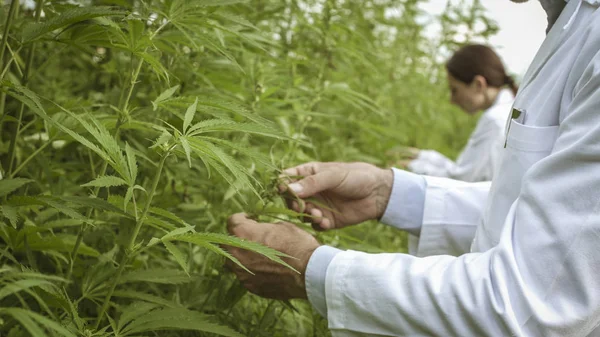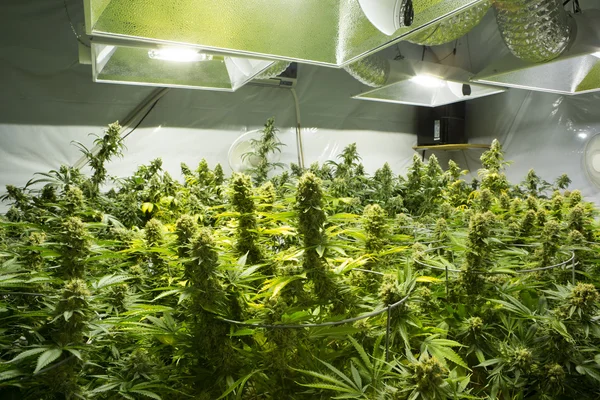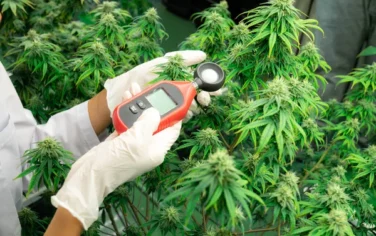The Future of Medical Marijuana Investments: Trends and Forecasts

November 08, 2024
I. Introduction
The medical marijuana market is experiencing unprecedented growth and transformation. As more countries legalize the use of cannabis for medical purposes, this sector is becoming one of the most dynamic and promising in the modern economy.
A. Overview of the Current State of the Medical Marijuana Market
Today, the global medical marijuana market is valued at $22.5 billion USD, showing an impressive compound annual growth rate (CAGR) of 19.3% over the last five years. More than 50 countries have legalized the medical use of cannabis, creating a solid foundation for the industry’s sustainable growth.
Key players such as Canopy Growth, Aurora Cannabis, and Tilray continue to expand their international presence, while new startups and innovative companies are emerging, offering unique products and solutions.
B. The Importance of Investments in This Sector
Investing in the medical marijuana sector offers a unique opportunity for several reasons:
1. High Growth Potential: the market is expected to continue growing at double-digit rates over the next decade.
2. Portfolio Diversification: medical marijuana represents a new asset class that allows investors to diversify their portfolios.
3. Innovative Potential: the sector is characterized by a high level of innovation, from new treatment methods to advanced cultivation and production technologies.
4. Social Impact: investments in medical marijuana can contribute to improving patients’ quality of life and advancing healthcare overall.

II. Current Trends in Medical Marijuana Investments
The medical marijuana investment market is evolving rapidly, showing several key trends.
A. Growth of Institutional Investments
There is a significant increase in interest from institutional investors:
1. Major investment funds and banks are starting to include medical marijuana companies in their portfolios.
2. In 2023, the volume of institutional investments in the sector grew by 45% compared to the previous year, reaching $8.7 billion USD.
3. The emergence of specialized ETFs (exchange-traded funds) focusing on medical marijuana companies makes the sector more accessible to a wider range of investors.
B. Increase in International Investments
The globalization of the medical marijuana market is driving the growth of international investments:
1. Canadian companies are actively investing in the European market, which is expected to become the world’s largest medical marijuana market by 2028.
2. Asian investors are showing increasing interest in North American and European medical marijuana companies.
3. The volume of cross-border deals in the sector grew by 60% last year, reaching $3.2 billion USD.
C. Focus on Research and Development
Investors are increasingly focusing on companies with strong research programs:
1. R&D investment in the medical marijuana sector grew by 75% last year, reaching $1.8 billion USD.
2. Companies developing new methods of cannabinoid delivery and exploring new therapeutic applications are of particular interest.
3. There is a growing number of partnerships between medical marijuana producers and traditional pharmaceutical companies to conduct clinical trials.
These trends demonstrate the growing maturity of the medical marijuana sector and its integration into the mainstream financial industry. As the market develops, investors can expect new opportunities as well as increased competition and regulatory oversight.
III. Key Factors Affecting the Future of Investments
A. Changes in Legislation and Regulation
Legislative changes continue to play a key role in shaping the investment landscape:
1. By 2026, another 15–20 countries are expected to legalize the medical use of marijuana, opening up new markets for investment.
2. Increased regulatory scrutiny may raise quality and safety standards, requiring additional investments in regulatory compliance.
3. Harmonization of international standards can facilitate cross-border trade and investments.
B. Scientific Research and New Medical Applications
Ongoing research opens up new investment opportunities:
1. Breakthroughs in the treatment of neurodegenerative diseases with cannabinoids are expected, potentially creating a new major market.
2. Research into the use of medical marijuana in pediatrics may expand new niches for specialized products.
3. The development of personalized medicine based on genetic profiling could lead to individualized cannabinoid-based medications.
C. Technological Innovations in Production and Delivery
Technological advances create new investment opportunities:
1. The development of cannabinoid biosynthesis could revolutionize production, reducing costs and improving product purity.
2. Innovative delivery systems such as nanosystems and transdermal patches can improve the efficacy and convenience of medical marijuana applications.
3. The application of AI and machine learning in drug development could accelerate the R&D process.
D. Globalization of the Medical Marijuana Market
Growing globalization presents new opportunities and challenges:
1. By 2027, international trade in medical marijuana is expected to reach $15 billion USD.
2. The formation of global supply chains can create new investment opportunities in logistics and distribution.
3. Competition between countries for leadership in the export of medical marijuana may lead to the emergence of new major players in the market.
IV. Promising Investment Areas
A. Companies Specializing in Specific Medical Applications
Specialization is becoming a key trend:
1. Companies focusing on chronic pain treatment are able to capture significant market share, given the global opioid addiction epidemic.
2. Businesses developing treatments for epilepsy and other neurological disorders are attracting increased attention from investors.
3. Investments in companies researching the use of cannabinoids in oncology are expected to grow.
B. Producers of Innovative Delivery Methods
Innovations in cannabinoid delivery methods are opening up new opportunities:
1. Companies developing precision-dosing inhalers could capture a substantial share of the medical marijuana market.
2. Increased investment is expected in the development of extended-release delivery methods, such as implants and depot injections.
3. Producers of water-soluble cannabinoids for beverages and dietary supplements are drawing heightened investor interest.
C. Biotechnology Companies Working on Synthetic Cannabinoids
Synthetic cannabinoids represent a promising area:
1. The synthetic cannabinoids market is expected to reach $30 billion by 2028.
2. Companies developing large-scale production methods for pure cannabinoids can become market leaders.
3. Investment in research into new synthetic analogs of natural cannabinoids with enhanced therapeutic properties is becoming increasingly attractive.
D. Tech Startups in the Medical Marijuana Sector
Technological solutions are playing an increasingly important role in the industry:
1. Companies developing AI systems for optimizing cultivation and production are raising significant investments.
2. Startups building telemedicine platforms for medical marijuana patients show high growth potential.
3. Investment in blockchain solutions for tracking the origin and quality of products is becoming more popular.
These promising directions indicate that the future of medical marijuana investment lies at the intersection of medicine, technology, and innovation. Investors who can identify and support the most promising areas may expect substantial long-term growth in their investments.

V. Market Growth Forecasts
A. Expected Growth of the Global Medical Marijuana Market
Analysts predict significant growth in the medical marijuana market in the coming years:
1. By 2028, the global medical marijuana market is expected to reach $148.35 billion USD, with a compound annual growth rate (CAGR) of 26.7%.
2. The number of patients using medical marijuana is anticipated to grow from 4.3 million in 2023 to 19.5 million by 2028.
3. The share of medical marijuana in the overall pharmaceutical market is forecasted to grow from 0.5% in 2023 to 2.5% by 2028.
B. Regional and Country Forecasts
Market growth will vary across regions:
1. North America: expected to maintain its leading position with a projected market size of $62.5 billion by 2028.
2. Europe: anticipated to have the fastest growth, with a CAGR of 29.6%, reaching a market size of $43.2 billion by 2028.
3. Asia-Pacific: predicted to grow significantly, from $3.5 billion in 2023 to $25.8 billion by 2028, mainly due to regulatory liberalization in key countries.
C. Potential New Markets
Several countries are considered potential major new markets:
1. Brazil: expected to become the largest medical marijuana market in Latin America by 2026, with a projected market size of $3.4 billion.
2. India: if legalized, it can become one of the largest markets globally, with a potential market size of up to $5 billion by 2028.
3. Japan: a conservative, but potentially enormous market, which may reach $2 billion by 2028 with favorable regulatory changes.
VI. Risks and Challenges for Investors
A. Regulatory Risks
Despite the general trend towards liberalization, regulatory risks remain significant:
1. The potential tightening of regulations in certain countries can reduce market size or increase compliance costs.
2. Uncertainty regarding international narcotics conventions may create barriers to international trade.
3. Differences in regulations between countries and even regions within countries complicate business scaling.
B. Competition from Pharmaceutical Giants
As the market grows, traditional pharmaceutical companies are taking an active interest:
1. Large pharmaceutical companies have significant resources for research and development, which can threaten the positions of existing players.
2. The ability of large companies to quickly capture the market through acquisitions and mergers poses risks for investors in smaller companies.
3. The lobbying power of pharmaceutical giants may lead to changes in the regulatory framework in their favor.
C. Market Volatility
The medical marijuana market is characterized by high volatility:
1. Stock prices of medical marijuana companies are subject to sharp fluctuations due to news of regulatory changes or research outcomes.
2. Seasonal fluctuations in supply and demand can lead to instability for companies` revenue.
3. Speculative investments and “hype” around the sector may create market bubbles.
D. Social Stigma and Resistance
Despite growing acceptance, social stigma remains an issue:
1. Negative perceptions of marijuana in some societies may limit market growth and create reputational risks for investors.
2. Resistance from conservative political forces may lead to delays in the liberalization of legislation.
3. Concerns over public health impacts may result in restrictions on advertising and marketing of products.
Understanding and addressing these risks and challenges are critical for successful investment in the medical marijuana sector. Investors must carefully analyze not only the growth potential but also the possible obstacles to the industry’s development.

VII. Strategies for Investors
A. Portfolio Diversification within the Sector
Diversification remains a key strategy for minimizing risks:
1. Invest in companies at different stages of the value chain: from cultivation to retail and research.
2. Allocate investments between companies of different sizes: from large public corporations to promising startups.
3. Geographical diversification: invest in companies operating across various regional markets.
B. Focus on Companies with Strong Research Programs
Investing in research and development can provide a long-term advantage:
1. Prioritize companies actively conducting clinical trials of new cannabinoid-based drugs.
2. Pay attention to businesses collaborating with leading research institutes and medical centers.
3. Evaluate the company’s patent portfolio as an indicator of its innovation potential.
C. Investments in Supporting Industries
Indirect investments can reduce risks and expand opportunities:
1. Invest in companies producing equipment for the cultivation and processing of marijuana.
2. Consider investing in tech companies developing software for production management and distribution.
3. Explore opportunities in related sectors such as non-psychoactive hemp or CBD products.
D. The Importance of a Long-Term Approach
Given the market’s volatility, a long-term approach may be most effective:
1. Focus on the fundamental indicators of companies, rather than short-term stock price fluctuations.
2. Be prepared for periods of market turbulence and maintain positions during downturns.
3. Regularly review and adjust your investment strategy in light of changes in the regulatory environment and technological developments.
VIII. The Role of ESG Factors in Medical Marijuana Investments
A. Environmental Aspects of Production
Sustainability is becoming an increasingly important factor:
1. Assess energy efficiency in production, taking into account the high energy consumption of indoor cultivation.
2. Focus on companies using renewable energy sources and implementing water conservation technologies.
3. Analyze waste management practices and the use of eco-friendly packaging materials.
B. Social Responsibility and Access to Treatment
Social factors play an important role in evaluating companies:
1. Consider companies’ policies regarding product accessibility for low-income patients.
2. Evaluate companies’ contributions to educational programs on medical marijuana use.
3. Analyze companies’ employment practices, including diversity and inclusion.
C. Corporate Governance and Transparency
High standards of corporate governance are critical in this emerging industry:
1. Assess companies’ transparency regarding their operations, financial performance, and development plans.
2. Analyze the composition of the board of directors and management teams for medical, pharmaceutical, and regulatory compliance experience.
3. Consider companies’ policies to prevent illegal use of their products and to maintain ethical marketing standards.
Incorporating ESG factors is becoming increasingly important for investors in the medical marijuana sector. Companies that demonstrate high standards in sustainability, social responsibility and corporate governance can gain a competitive advantage and attract more long-term investment.
Investors who consider these factors when making decisions not only contribute to the development of a more sustainable and responsible industry, but also potentially reduce their risks and improve long-term investment returns.

IX. Comparison with Other Healthcare Sectors
A. Growth Potential Compared to Traditional Pharmaceutical Investments
The medical marijuana sector shows unique growth characteristics:
1. The sector’s CAGR is forecasted at 26.7% up to 2028, significantly higher than the traditional pharmaceutical market’s CAGR of 5.9%.
2. The market capitalization of leading medical marijuana companies has grown by 215% over the past three years, while the market cap of the major pharmaceutical companies accounted for 45%.
3. R&D investments in the medical marijuana sector average 15-20% of revenue, which is comparable to investments by innovative biotech companies.
B. Unique Advantages and Disadvantages
Investing in medical marijuana has its unique features:
Advantages:
1. High growth potential due to the expansion of legal markets and new medical applications.
2. Less reliance on patent protection compared to traditional pharmaceutical products.
3. Ability to bring new products to market quickly due to less stringent regulatory requirements in some jurisdictions.
Disadvantages:
1. Higher regulatory risks and uncertainties because of differences in legislation between countries and regions.
2. Limited access to banking services and financing in some jurisdictions.
3. Potential reputational risks for institutional investors.
X. Conclusion
A. Summary of Key Trends and Forecasts
1. The global medical marijuana market will continue to grow rapidly and reach $148.35 billion by 2028.
2. Further legislative liberalization in key regions is expected, opening new markets for investment.
3. Technological innovations, especially in cannabinoid synthesis and new delivery methods, will play a key role in industry development.
4. Growing interest from major pharmaceutical companies may lead to market consolidation.
5. ESG factors are becoming increasingly important in evaluating the investment attractiveness of companies in the sector.
B. Recommendations for Potential Investors
1. Diversify investments within the sector, including companies at different stages of the production chain and in different geographic regions.
2. Pay close attention to companies with strong research programs and innovation potential.
3. Consider opportunities for investment in supporting industries to mitigate risks.
4. Stick to a long-term approach given the market volatility.
5. Carefully assess regulatory risks in various jurisdictions before making investment decisions.
6. Consider ESG factors when evaluating companies, as they can impact long-term business sustainability.
C. Long-Term Prospects for the Medical Marijuana Sector
The medical marijuana sector is on the cusp of significant transformations and holds immense growth potential. As scientific research advances and the range of medical applications for cannabinoids expands, this sector is expected to become an integral part of the global healthcare system.
Investors willing to take on the higher risks and uncertainties inherent in an emerging industry can reap substantial benefits from participating in the growth of this promising market. However, success will depend on thorough analysis, a strategic approach to portfolio building, and a willingness to adapt to the rapidly changing market and regulatory environment.
In the long term, the medical marijuana sector has the potential to not only generate substantial financial returns for investors, but also make a significant contribution to improving the quality of life for millions of patients worldwide by opening new opportunities for treating various diseases.
We thank all our investors and community members for their trust and ongoing support. Together, we are not just growing cannabis; we are growing a vibrant, innovative community that values transparency, security, and shared success.
https://polygonscan.com/address/0x4c1b0dff6de00b0d5a1dcb1400719e9d8123a978
Other News

Introduction: A New Era of Investment Opportunities 2025 ushers in unprecedented opportunities for investors in the rapidly growing medical cannabis sector. According to Grand View Research, the global medical cannabis market is on the brink of historic growth, with a projected value of $346.2 billion by 2030. A steady annual growth rate of 14.9% makes […]

About the Transition to USDC As of December 30, 2024, Tetra Farm has fully transitioned from USDT (Tether) to USDC (USD Coin). This change applies to all financial operations within the project, including: Purchasing NFTs Profit distribution to project participants All internal transactions Reasons for Transitioning to USDC Compliance with New EU Regulations With the […]

Introduction Laura Stewart, a professor at the University of Northern Colorado, has been studying the impact of physical exercise on immunity for over 20 years. However, her interests have shifted towards the relationship between cannabidiol (CBD) and immune system function in the last decade. The scientist is captivated by this topic, as she has discovered […]

